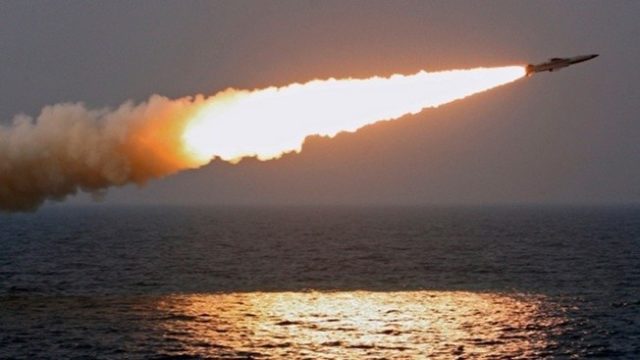
Tsirkon Hypersonic Cruise Missile Tested by the Northern Fleet
Publication: Eurasia Daily Monitor Volume: 17 Issue: 148
By:

On October 6, Russia’s Northern Fleet again tested the new anti-ship 3M22 Tsirkon hypersonic cruise missile, launching it from the White Sea. The high-profile weapons system is one of several hypersonic missiles under development referred to by President Vladimir Putin in his address to the Federal Assembly in February 2019, promoting these as part of Moscow’s longer term military modernization program. The Tsirkon was tested earlier this year, in January 2020, when the Northern Fleet fired the missile against a ground target in the Urals (see EDM, June 10, 2020). However, this latest test launch marked an important milestone, as it was specifically sea based. The Russian Ministry of Defense aims to procure the Tsirkon cruise missiles for submarines and surface vessels in the Military-Maritime Fleet (Voyenno-Morskoy Flot—VMF) during 2020–2021. Navy officials hailed the latest trial a success (Zvezda Weekly, October 19).
In Novo-Ogarevo, on the morning of his birthday, on October 7, President Putin joined a video link to the chief of the General Staff, Army General Valery Gerasimov. Putin was briefed on the successful testing of the Tsirkon. Gerasimov explained to a jubilant Putin, “This is the first time a Tsirkon hypersonic cruise missile has been fired at a sea target located in the Barents Sea,” adding, “The test was recognized as successful. A direct hit of the missile on the target was recorded. The missile’s flight range was 450 kilometers, the maximum altitude was 28 kilometers. The flight time is four and a half minutes. It achieved hypersonic speed of over Mach 8” (Nezavisimoye Voyennoye Obozreniye, October 15).
Putin responded to Gerasimov’s report by hailing it as a major breakthrough: “The work on the Tsirkon system and the stage that you just reported, the stage of successful testing of this missile, is a great event not only in the life of the Armed Forces, but also in the whole of Russia, the whole country, since the equipping of our Armed Forces—the army and fleet—with the newest, truly unparalleled in the world, weapons systems certainly and in the long term ensures the defense capability of our state” (Nezavisimoye Voyennoye Obozreniye, October 15). Indeed, Putin has previously also referred to the creation of a land-based version of the Tsirkon system. However, some of the details emerging around the test launch offer fresh insight into the characteristics of the Tsirkon and help explain Putin’s enthusiasm for the project (Zvezda Weekly, October 19).
Russian military media sources confirm the characteristics of the Tsirkon as outlined by Gerasimov. Launched from the Admiral Gorshkov frigate in the White Sea, the missile struck a target in the Barents Sea at a distance of 450 km. These sources also concur that the Tsirkon reached Mach 8. According to other sources in the Russian military media, the Tsirkon, like the Kalibr cruise missiles, may have a maximum range of up to 1,500 km (VPK, October 20).
Russian military specialists estimate that the sea-based Tsirkon cruise missile is around nine meters in length. This is consistent with the universal launcher tubes used in the VMF for the firing of the Kalibr cruise missiles (3M14, 3M54 and 91R). The sea-based Tsirkon has a multi-stage launch system, with a booster, a solid-propellant booster stage and a scramjet-powered warhead. Putin has stated the Tsirkon has a range of up to 1,000 km. This appears plausible in theory, if the warhead is limited to 300 kilograms with an optimized trajectory achieving maximum range with its high point at 30–40 km. Nonetheless, the VMF is more likely to use a heavier warhead, at around 400–500 kg, with lower flight altitudes in order to reduce the enemy detection time. This makes the more likely operational range around 700–750 km. More significantly, the Tsirkon’s speed of 3 km per second results in the formation of plasma around its body, suggesting that enemy radars would struggle to detect the missile (Nezavisimoye Voyennoye Obozreniye, October 15).
Any surface ship in the VMF equipped with the universal launchers for the Kalibr cruise missiles would be able to host the new Tsirkon. This solves the issue of its placement and launch. However, the real challenge lies in target acquisition. The VMF’s target acquisition is normally limited by the horizon line, which can be compensated by coordination with naval aviation. Frigates of the Admiral Gorshakov class have a hanger for the Ka-27 helicopter, which would assist in the enhancement of locating the target. However, this radar issue still constrains the effective use of long-range precision strike systems. The timely detection and classification of targets at maximum range meets a serious challenge, limiting the employment of long-range strike systems at sea. The solution lies in over-the-horizon radars as well as early-warning and space-based systems. This will prove to be the critical test for the VMF in successfully exploiting such systems as the Kalibr and Tsirkon at maximum ranges (Nezavisimoye Voyennoye Obozreniye, October 15).
Among Russia’s fleet of orbital craft (see EDM, April 27, August 14), there are a pair of Condor satellites launched into orbit in 2013. These will need to be renewed, while a concerted effort will be required to enhance this aspect of target designation. The VMF will undoubtedly benefit from the introduction of the new Tsirkon once it passes the state trial phase and is finally procured (Nezavisimoye Voyennoye Obozreniye, October 15). Yet the advertised range of such systems may well prove to be more conservative. Putin’s political interest in such hypersonic weapons is rooted in the confidence those systems offer in overcoming enemy air defenses. No reliable estimates exist as to the cost of producing each missile, however, or the total planned numbers for the VMF inventory. Still, if it can achieve the speeds referred to in its testing phase, the Tsirkon could prove itself as a worrisome asset to potential adversaries, as Moscow tries to find ways to maintain the maritime balance of power.



